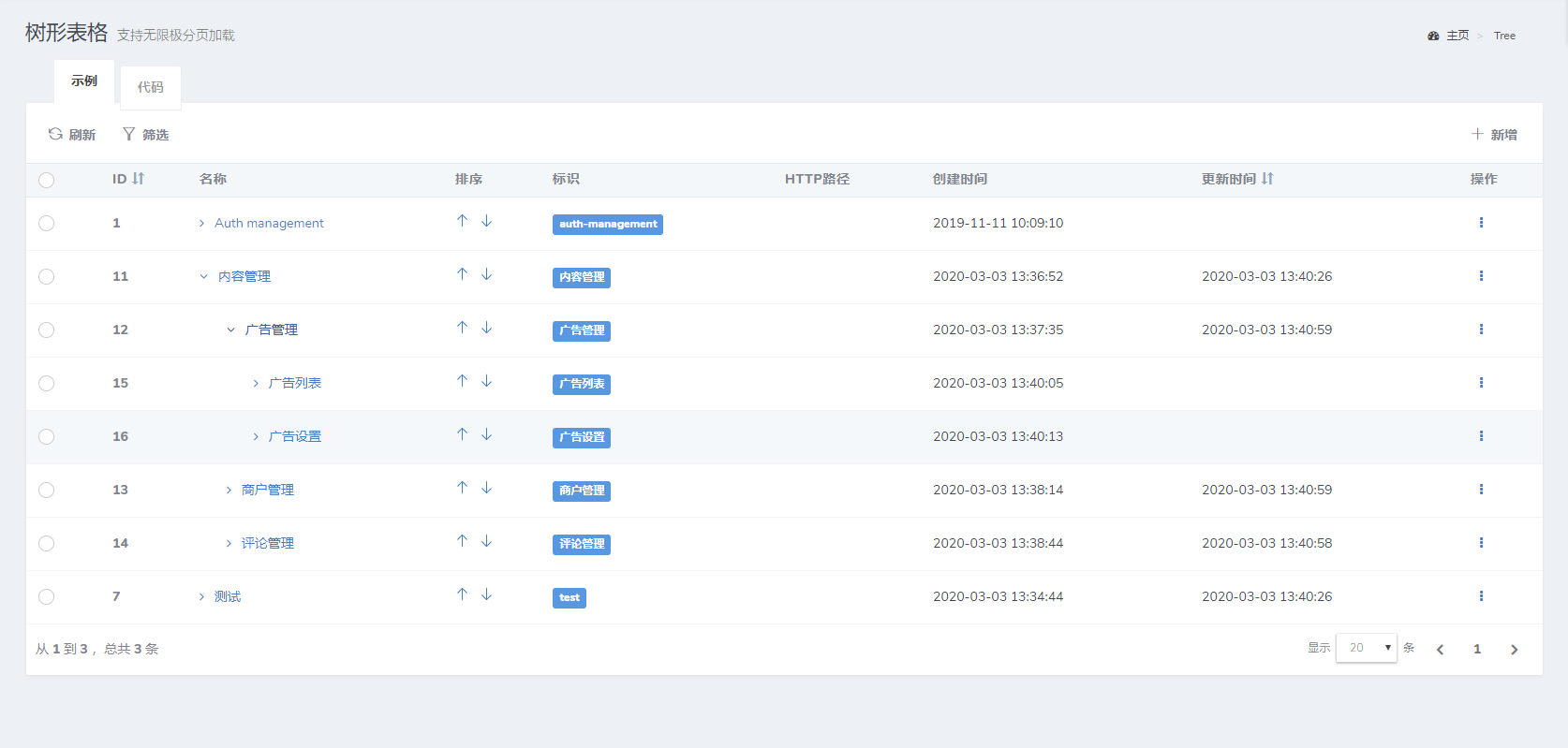Tree table
The tree table supports pagination and click-to-load functionality and is particularly suitable for displaying large amounts of data in a multi-level structure.

Table structures and models
To use a tree table, follow the agreed table structure:
{tip} This table structure and model are fully compatible with
model-tree.
CREATE TABLE `demo_categories` (
`id` int(10) unsigned NOT NULL AUTO_INCREMENT,
`parent_id` int(11) NOT NULL DEFAULT '0',
`order` int(11) NOT NULL DEFAULT '0', // order 字段不是必须的,不设置也可以
`title` varchar(50) COLLATE utf8_unicode_ci NOT NULL,
`created_at` timestamp NOT NULL DEFAULT CURRENT_TIMESTAMP,
`updated_at` timestamp NOT NULL DEFAULT CURRENT_TIMESTAMP ON UPDATE CURRENT_TIMESTAMP,
PRIMARY KEY (`id`)
) ENGINE=InnoDB DEFAULT CHARSET=utf8 COLLATE=utf8_unicode_ciThe above table structure has three required fields inside parent_id, title, the other fields are not required.
The corresponding model is app/Models/Category.php:
{tip} For ease of reading, the
Repositorycode is no longer shown here.
<?php
namespace App\Models\Demo;
use Dcat\Admin\Traits\ModelTree;
use Illuminate\Database\Eloquent\Model;
class Category extends Model
{
use ModelTree;
protected $table = 'demo_categories';
}The names of the three fields parent_id, order and title in the table structure can also be modified:
<?php
namespace App\Models\Demo;
use Dcat\Admin\Traits\ModelTree;
use Illuminate\Database\Eloquent\Model;
class Category extends Model
{
use ModelTree;
protected $table = 'demo_categories';
protected $titleColumn = 'name';
protected $orderColumn = 'sort';
protected $parentColumn = 'pid';
}If your data table does not require the order field to be sorted, add the following code to the model
<?php
namespace App\Models\Demo;
use Dcat\Admin\Traits\ModelTree;
use Illuminate\Database\Eloquent\Model;
class Category extends Model
{
use ModelTree;
protected $table = 'demo_categories';
// Disable the order field by returning a null value.
public function getOrderColumn()
{
return null;
}
}Use
The tree table function can be enabled by calling Grid\Column::tree method, after that, only the data of the top node will be queried by default.
<?php
namespace App\Admin\Controllers\Demo;
use App\Models\Category;
use Dcat\Admin\Grid;
use Dcat\Admin\Controllers\AdminController;
class CategoryController extends AdminController
{
protected function grid()
{
return Grid::make(new Category(), function (Grid $grid) {
$grid->id('ID')->bold()->sortable();
$grid->title->tree(); // Enable the tree table feature
$grid->order;
$grid->created_at;
$grid->updated_at->sortable();
$grid->filter(function (Grid\Filter $filter) {
$filter->like('slug');
$filter->like('name');
$filter->like('http_path');
});
});
}
}The above code executes sql as follows (by default, only data with parent = 0 is queried):
select count(*) as aggregate from `demo_categories` where `parent_id` = 0
select * from `demo_categories` where `parent_id` = 0 order by `order` asc, `id` asc limit 20 offset 0Grid\Column::tree Method parameters
bool$showAllfalseWhether to display all the nodes of the next level at once, the default pagination displaybool$sortabletrueWhether to enable the sorting function
// Disable paging and load all next level nodes at once.
$grid->title->tree(true);
// No need to sort the order field, pass false for the second argument
$grid->title->tree(false, false);orderable排序
The orderable sorting function relies on the spatie/eloquent-sortable component, which requires modifying the model:
use Spatie\EloquentSortable\Sortable;
class Category extends Model implements Sortable
{
use ModelTree;
// Set the sort field, default order
protected $orderColumn = 'sort';
}Here's how to use Example
class CategoryController extends AdminController
{
protected function grid()
{
return Grid::make(new Category(), function (Grid $grid) {
$grid->id('ID')->bold()->sortable();
$grid->title->tree(); // Enable the tree table feature
$grid->order->orderable(); // Enable sorting function
...;
});
}
}About Data Search
If the search function is used in the tree table (Grid::filter, Grid\Column::filter, Grid::quickSearch), it cancels the operation of searching only the top-level data in order to allow the user to search for the desired data.
{tip} Using search functions such as query filters, column filters, quick-search all cancel the operation of searching only the top-level data. with the exception of features such as filter and scope query scope.
For example, the following code enables quick search
class CategoryController extends AdminController
{
protected function grid()
{
return Grid::make(new Category(), function (Grid $grid) {
$grid->id('ID')->bold()->sortable();
$grid->title->tree(); // Enable the tree table feature
$grid->order->orderable(); // Enable sorting function
$grid->quickSearch(['id', 'title']);
...;
});
}
}and the user uses a quick search in the browser, then sql is generated as follows
select count(*) as aggregate from `demo_categories` where `id` like "%xxx%" or `title` like "%xxx%"
select * from `demo_categories` where `id` like "%xxx%" or `title` like "%xxx%" order by `order` asc, `id` asc limit 20 offset 0Difference from model tree function
The model-tree can also be used to display multi-level structured data, and support drag-and-drop data hierarchy, sorting, and other operations, but does not support paging and click to load the function, can only load all the data at once. Therefore, model-tree is not suitable for displaying data with large amounts of data.
The tree table supports pagination and click to load, suitable for displaying large amounts of data multi-level structured data, but does not support the use of drag and drop to achieve the data hierarchy, sorting operations.